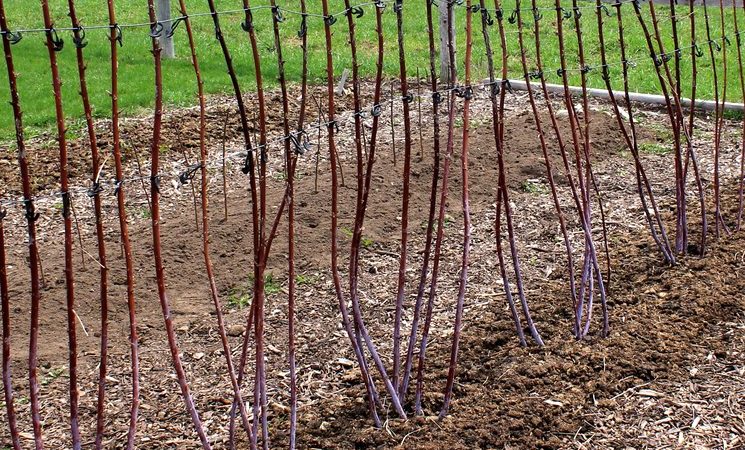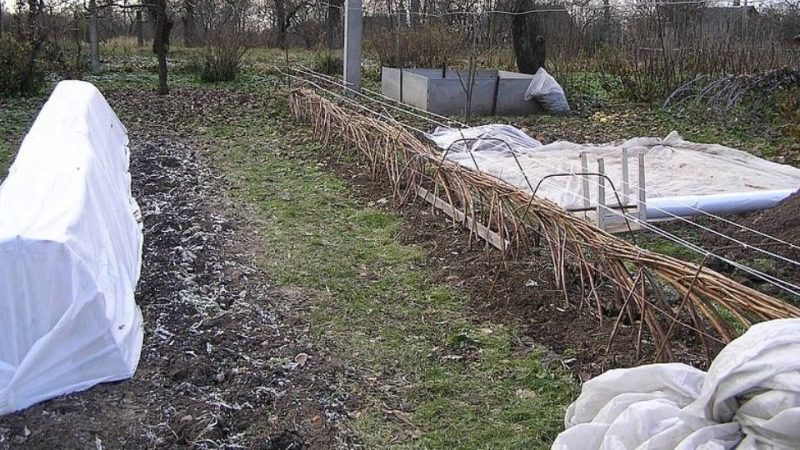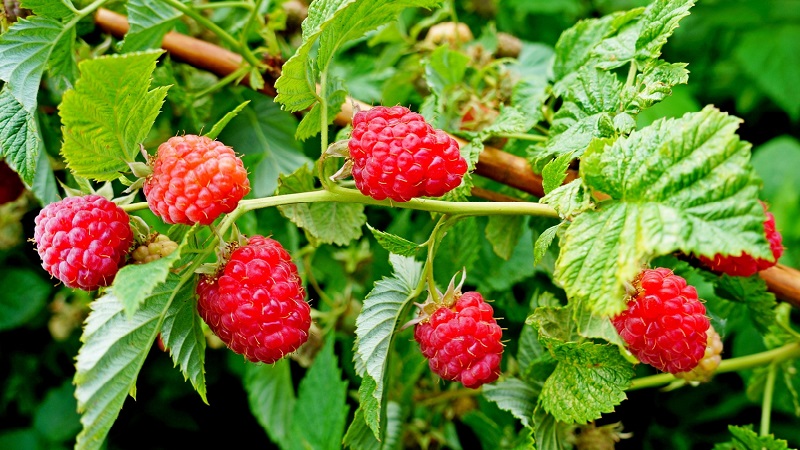Proper care of raspberries in the fall: preparing for winter in stages
Raspberries, although they are unpretentious, need mandatory preparation for winter. The procedures are carried out in the fall in several stages, following a number of recommendations, which allows you to keep the bushes in a healthy and well-groomed state until the next season.
The content of the article
How to care for raspberries in autumn

In the care of raspberries in the fall, there are two main periods: early autumn and late autumn.
The first, early period is the end of August, when the harvest ends and the growth of the plant itself slows down, which gradually begins to prepare for wintering.
The second, late period, begins at the first leaf fall and continues until the very frost. At this time, active biological processes are completed near the raspberry bushes.
In preparation for winter, raspberries need: top dressing, pruning fertile branches and thinning of young shoots after the final harvest, as well as preventive treatment against diseases and pests, watering, if necessary, and shelter, depending on the region.
Autumn activities for good raspberry yields
Raspberry care in the fall includes several basic activities.
Pruning

It is performed on early varieties - in the first half of September, on late ones - in mid-October.
To begin with, remove all green shoots, because they will no longer grow before the onset of the winter cold. They also remove the branches that have finished bearing fruit, as a rule, two-year-old branches, as well as thin, weak and affected by pests.
A certain number of shoots are left for the winter:
- 7-10 strongest healthy and powerful annual growths, shortened by a quarter;
- an additional number of branches to them equal to the number of cut out;
- another 20% of the total number of shoots for the "reserve".
This method of pruning shrubs increases yields in the following seasons and creates a reserve in case of frosty and little snowy winters.
Important. It is better to cut off the fruit bearing shoots completely, to the very root.
Often in the fall, in addition to pruning, complete thinning of the bushes is also carried out so that the distance between them remains about 60 cm.
Reference. In addition to the autumn pruning of raspberry shoots and branches, it is recommended to remove all leaves (strictly in the direction from bottom to top) - during the wintering period, the remaining leaf plates will rot and cover the buds of the plant too tightly.
Top dressing
The soil in the raspberry tree must be dug up in the fall, fertilizing in parallel. Autumn dressing helps shrubs prepare for cold weather and survive winter favorably. In addition, the soil fertilized in the fall will provide the plants with all the substances necessary for growth and fruiting in the spring.
Whether to apply fertilizers in the fall depends on the condition of the soil on the site. Experienced gardeners recommend the following types of supplements:
- Manure make before digging raspberries, about 4-6 kg per 1 sq. m.
- Compost - an overripe mixture of foliage, peat, poultry droppings and weeds, used instead of manure.
- Peat - top dressing, which significantly improves the structural properties of the soil.
- Organic and mineral fertilizers used every 2-3 years. Before wintering, potash salt and superphosphates are usually added, about 40 g and 60 g per bush.
- Siderata (mustard, blue lupine, vetch-oat mixture) are sown between the rows of raspberries in June, and in the fall they are dug up with the soil and left to rot.
- Trace elements - auxiliary additives used to strengthen and increase the winter hardiness of raspberries, about 3 g of zinc sulfate and 5 g of manganese sulfate per 1 sq. m of soil.
An overabundance of fertilizers for fruit and berry bushes is harmful, as it contributes to their oppression and reduces disease resistance.
Watering
In the early autumn period, the number of watering of raspberries is reduced, gradually reducing them to a minimum, until they are completely stopped. In this case, all the same, the soil must not completely dry out, especially if there is no rain. About a bucket of water per square meter m every other day is quite enough for autumn watering.
The final abundant watering is carried out until the soil freezes, spilling it well, 2-3 buckets per 1 sq. m. The plant should not be left for the winter with a dry root system.
Treatment
With the onset of the first frosts, raspberry bushes process 2% Bordeaux liquid in the direction from the roots to the shoots and throw snow under them if it has already fallen. This is a mandatory procedure for processing berry bushes.
In general, in the late autumn period, the following types of processing are recommended:
- from fungi - a solution of Bordeaux liquid;
- to combat moss and lichen - tillage with a weak solution of copper sulfate;
- from insects - insecticidal solutions "Fufanon", "Actellika" or "Intavira".
- treatment of shrub sections with iron vitriol.
Protection against diseases and pests
Prevention of raspberry diseases is carried out in late autumn. At this time, all garbage, broken branches, possible residues of mulching or weeds, fallen leaves from under the bushes are removed and burned. Repeated prophylactic treatment of the plant with Bordeaux liquid is carried out, and a 5% concentration is already used. Shrubs are treated, as a rule, in clear weather, so that before and after the procedure, the shoots are in a dry state.
If desired, it is possible to treat raspberry bushes with approved insecticides and special preparations for pests and diseases, for example, "Allegro", "Aktara".
Preparing raspberries for winter

After completing all the preparatory stages of autumn care for raspberries, they begin to place them for wintering.
Shelter, insulation
Raspberry winter shelter is most relevant in the northern regions of Russia. Much depends on the variety and on the general nature of winter in a particular region.
Important. If the bushes are already covered, but the weather suddenly turns warm, landing it is better to open it to avoid overheating.
It is recommended to cover:
- heat-loving varieties;
- in regions with very cold winters;
- in an area with no snow cover in winter, but with a fairly frosty climate;
- thornless varieties that attract rodents.
Experienced gardeners are advised to cover for the winter any, even frost-resistant varieties of raspberries, as this keeps the bushes from strong winds and drafts.
Raspberry hiding methods
In practice, the following methods of sheltering berry bushes for the winter are possible:
- Bending down the bushes - the raspberry lashes are carefully tilted and bent to the ground and tied to any vertical peg or other support for fastening so that they are covered with snow in winter.
- Vertical garter - inside the bushes, a holder is fixed to which all branches are attached, and then the entire shrub mass is covered with agrofibre and tied with a rope.
- Burying - a small depression of 15-20 cm is made in the ground, corresponding to the length of the raspberry stems, they are tied together and buried in the ground. This method is more suitable for low-growing varieties.
In early spring, buried bushes need to be removed in time to prevent their death from lack of air.
Features of caring for a raspberry tree

There are important features of caring for a berry crop, depending on the age, variety and region of cultivation.
The nuances of caring for young bushes
Autumn care for raspberry seedlings is slightly different from the preparation period for adult plants. They do not require autumn trimming, but need special attention when choosing a shelter for wintering. Such plants that are still not strong enough are very neatly bent and tied, trying not to damage or break them. For the winter for immature seedlings, covering natural or artificial materials are used.
Regional differences in berry care
Depending on the growing regions of raspberry bushes, different methods of covering and warming them are used.
In cold regions, straw and mown green manures are used for mulching. Often used for the winter shelter of bushes special artificial materials (geotextile, spunbond).
In the southern and middle lane, the usual bending of the shoots is enough to prepare the raspberries for the winter period.
Caring for different varieties of shrubs
Autumn care for any varieties of raspberries includes all the main stages without significant differences.
Conclusion
The autumn preparation of raspberry bushes for wintering involves mandatory pruning, feeding, sufficient watering and treatment from diseases and pests. After these procedures, the plants are covered in a suitable way and left for the winter. Proper and complete care of raspberries in autumn contributes to their preservation in the winter and increases future yield.